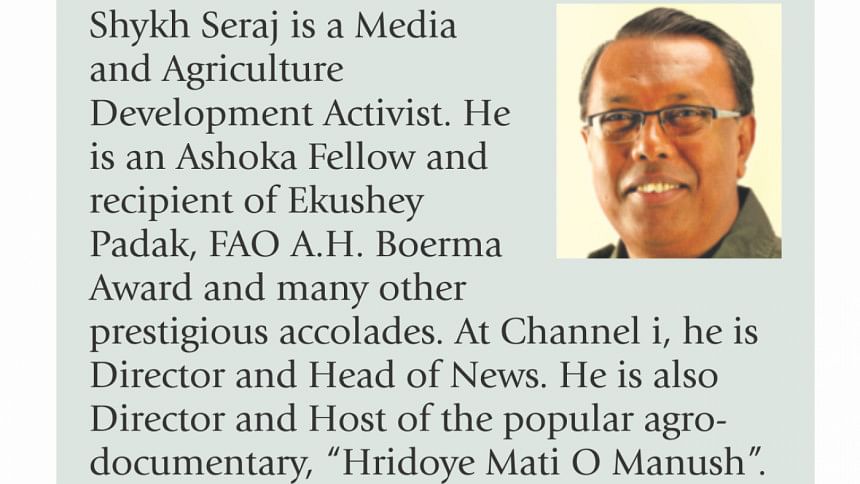Returning to roots: Beyond borders

Dear readers, a few months back I went to USA's Westchester Tarrytown. It is an hour's drive from New York. The signboard, Stone Barns Center for Food & Agriculture was visible from the road. In fact, my destination was there. It is a private agricultural institution. Here, they work on seasonal and organic crops, study soil's characteristics and do many other agricultural research and practices. They also bring students from different schools and colleges here. They provide hands-on knowledge and pragmatic training to the students. A yearlong training is also provided to those who want to be farmers in future. The students come here for two to four days and learn how organic crops are cultivated and how to stay away from GMO (Genetically Modified Crops), pesticides, chemical fertilizer etc. You might remember the Hridoye Mati O Manush (Soil & People in Heart) special initiative with the students, Firey Chol Matir Taney (Returning to Roots/RTR). You are already aware that I take the urban students to villages to give them primary knowledge on farming and farmers' life in a completely rural setting. They learn how crops are produced, processed and finally how food comes to our plates. There are two versions of RTR, one is for the university students and the other for the fifth graders at the schools, which is known as RTR Junior.
Juniors learn how to sow potatoes and harvest the produce after a certain time. University students are taken through a bit harder process. They go to villages and are hired by farmers as farm labourers. They work and stay there just like the labourers. When I visit different countries of the world to film great agricultural practices, I notice that many institutions let the students do such works in Europe and the USA. Earlier, the practice was rare. Now, it is being practiced in many countries and also among students from different universities around the world.
Surrounded by hills, Stone Barns is an integrated agricultural management in a wonderful natural setting. It is an agricultural production centre and also a multipurpose research institute. There are arrangements of practical education for every class of students. Similarly, they identify the flaws of traditional agriculture system practically. This institute is placed on 80 acres of land. It is owned by the famous industrialist and politician David Rockefeller and his daughter. With their initiative, a dairy farm was first established here. Gradually, it turned into an institution that provides scientific insight on multipurpose agricultural production and the quality of agriculture product. At Stone Barns Center for Food & Agriculture, there is an expensive restaurant called Blue Hill. It serves the farm food directly. Since 2004, Rockefeller family made the place open for different institutions and individuals for agricultural education. Now, a 13-member board of directors is running the management. All of them have passion and vast knowledge in farming.
As I made an appointment beforehand, PR Executive Jessica welcomed us. She told us about the works done in this place. Specially, the difference between traditional and modern agriculture is clearly seen here. However, organic farming is given more priority at the Stone Barns.
It reminds me of Scotland's Whitmuir organic farm. Over there, children regularly learned about agriculture production and food preparation.
On the other hand, it also reminded me of Underwood Family Farms, 50 miles away from Los Angeles at Moorpark in USA. You must have watched all these documentaries on Hridoye Mati O Manush. From children to old people, everyone pick their favourite fruits and vegetables from field and bring those to the cash counter for payment.
“We are picking strawberries and different vegetables. We bring our children here. They enjoy picking vegetables as well,” one mother was saying.
We met a team of students in the field at Stone Barns. They were being trained practically. We talked to the Education Director of this institute, Rene Morian.
“What grade are they in and where do they come from?”
“They are in the ninth and from a college of New York.”
“Is there anything special they are learning?”
“They are trying to understand the change of agriculture. No matter how much we accept agriculture as a controlled production system, it depends on all the natural energies and other factors.”
That's what they are being taught here.
“Is our traditional agriculture changing massively?” I asked Rene.
“Yes, we are already noticing the changes,” replied Rene.
The forefathers of these students were farmers. They are not aware of the significant past. It is time to inform the truth to them.
“Do they understand the severity of climate change? Even if they don't understand it properly yet, it is very important for them to know now,” Rene added.
“We try to provide some practical insights on farming beside academic education,” Rene stressed on this point.
I saw some more young people working on field. I asked Rene about them.
“They are involved in the long term agricultural education programme. You can talk to them,” said Rene.
“What is your name?”
“Lawrence.”
“What are the courses you have done here so far?”
“I am doing a nine-month-long integrated farming course. The first three months of it was livestock. Completing it, I have done the three-month-long course on forestry. Now, I am doing agricultural education,” said Lawrence.
The ones who are working here are done with their studies. They are doing a nine-month-long practical agriculture course to actually become farmers. They are not sticking to crop agriculture only. They are being trained on poultry, dairy and every other agriculture subject.
The students are being taught about the production system of crops in the field. Similarly, they are learning about plant's diseases, using pesticides and other important matters. Students are roaming through the forest beside a vast crop field. At the same time, they are learning about water management and many other key farming factors.
They took some students into the forest inside the Stone Barns property. Here, they are taught about water and other natural food elements. They are learning about algae, organic fertilizers etc. They are also told to refrain from using chemical fertilizers and pesticides. Students learn about cutting vegetables at the kitchen and they also cook.
Dear readers, going to Stone Barns reminded me all through about Firey Chol Matir Taney. I talked with some more students about their experience at Stone Barns.
“You have learned a lot from here. Do you wish to be a farmer?”
“I might not be a farmer. But I intend to use everything I learned about agriculture. Everybody should learn these.”

“What did you learn? I learned how seeds and seedlings are planted, how trees are watered, how plants take nutrients from soil, how to harvest crops and eat them etc. We have enjoyed a lot while learning about all this.”
Later on, the students are also given practical training on preparing food. Every culinary lesson is provided to cook and prepare fresh and healthy food. Both food production and food preparation are done here.
I have been doing Firey Chol Matir Taney for a long time to involve people in farming and nature, or at least making them aware of it. Similarly, the same work is being done here and in different places around the world.
Stone Barns Center for Food & Agriculture has been inventing and developing new agro-technologies for a long time. Similarly, they are training the students in such a way on agriculture practices that the students can do it anywhere, anytime.
Dear readers, at this time, policymakers worldwide are prioritizing to teach every citizen crop production practices for the sake of food security, food safety. Specially, the new generation must acquire knowledge on farming. To build a bridge between the soil and human, from educational institutes to guardians, everyone has equal role to play which definitely will bring a new revolution in farming in near future.

 For all latest news, follow The Daily Star's Google News channel.
For all latest news, follow The Daily Star's Google News channel. 



Comments